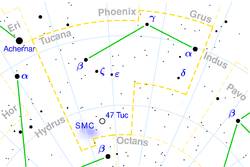Zeta Tucanae
| Observation data Epoch J2000 Equinox J2000 | |
|---|---|
| Constellation | Tucana |
| Right ascension | 00h 20m 04.25995s[1] |
| Declination | −64° 52′ 29.2549″[1] |
| Apparent magnitude (V) | 4.23 |
| Characteristics | |
| Spectral type | F9.5 V[2] |
| U−B color index | 0.02[3] |
| B−V color index | 0.58[3] |
| Variable type | None[4] |
| Astrometry | |
| Radial velocity (Rv) | 8.8 ± 0.02[5] km/s |
| Proper motion ( | RA: 1,707.42[1] mas/yr Dec.: 1,164.30[1] mas/yr |
| Parallax ( | 116.46 ± 0.16 mas[1] |
| Distance | 28.01 ± 0.04 ly (8.59 ± 0.01 pc) |
| Absolute magnitude (MV) | 4.67[6] |
| Details | |
| Mass | 0.99±0.02[7] M☉ |
| Radius | 1.08±0.08[8] R☉ |
| Luminosity | 1.26[8] L☉ |
| Surface gravity (log g) | 4.48[9] cgs |
| Temperature | 5,970[9] K |
| Metallicity [Fe/H] | −0.18[9] dex |
| Rotation | 31.1±0.1 d[10] |
| Rotational velocity (v sin i) | 3.0[11] km/s |
| Age | 2.1–3.02[12][13] Gyr |
| Other designations | |
| Database references | |
| SIMBAD | data |
Zeta Tucanae, Latinized from
The composition and mass of this star are very similar to the Sun, with a slightly lower mass and an estimated age of three billion years. The solar-like qualities make it a target of interest for investigating the possible existence of a life-bearing planet.[15]
Based upon an excess emission of infrared radiation at 70 micrometres, this system is believed to have a debris disk. The disk is orbiting the star at a minimum radius of 2.3 astronomical units. It is radiating with a maximum temperature of 218 K.[12] As of 2009, no planet has been discovered in orbit around this star.[16]
The components of this star's space velocity are U = −60, V = −4 and W = −38 km/s. These correspond to the velocity toward the Galactic Center, the velocity along the direction of galactic rotation, and the velocity toward the north galactic pole, respectively.[17] It is orbiting through the galaxy at a mean distance of 8.4 kpc from the Galactic Center and with an orbital eccentricity of 0.16.[15]
See also
References
- ^ a b c d e f van Leeuwen, Floor (November 2007), "Validation of the new Hipparcos reduction", Astronomy and Astrophysics, 474 (2): 653–664, arXiv:0708.1752v1, Bibcode:2007A&A...474..653V, doi:10.1051/0004-6361:20078357, S2CID 18759600 Note: see VizieR catalogue I/311.
- ^ Gray, R. O.; et al. (July 2006), "Contributions to the Nearby Stars (NStars) Project: Spectroscopy of Stars Earlier than M0 within 40 pc-The Southern Sample", The Astronomical Journal, 132 (1): 161–170, arXiv:astro-ph/0603770, Bibcode:2006AJ....132..161G, doi:10.1086/504637, S2CID 119476992
- ^ a b Johnson, H. L.; Iriarte, B.; Mitchell, R. I.; Wisniewskj, W. Z. (1966). "UBVRIJKL photometry of the bright stars". Communications of the Lunar and Planetary Laboratory. 4 (99): 99. Bibcode:1966CoLPL...4...99J.
- ^ a b Adelman, S. J. (February 2001). "Research Note Hipparcos photometry: The least variable stars". Astronomy and Astrophysics. 367 (1): 297–298. Bibcode:2001A&A...367..297A. doi:10.1051/0004-6361:20000567.
- ^ Evans, D. S. (June 20–24, 1966). "The Revision of the General Catalogue of Radial Velocities". In Batten, Alan Henry; Heard, John Frederick (eds.). Determination of Radial Velocities and their Applications, Proceedings from I
AU Symposium no. 30. University of Toronto: International Astronomical Union (published 1967). pp. 57–63. Bibcode:1967IAUS...30...57E. - ^ Elgarøy, Øystein; Engvold, Oddbjørn; Lund, Niels (March 1999), "The Wilson-Bappu effect of the MgII K line - dependence on stellar temperature, activity and metallicity", Astronomy and Astrophysics, 343: 222–228, Bibcode:1999A&A...343..222E
- ^ a b Santos, N. C.; Israelian, G.; Mayor, M. (July 2001). "The metal-rich nature of stars with planets". Astronomy and Astrophysics. 373 (3): 1019–1031. arXiv:astro-ph/0105216. Bibcode:2001A&A...373.1019S. doi:10.1051/0004-6361:20010648. S2CID 119347084.
- ^ a b Ghezzi, L.; et al. (September 2010), "Stellar Parameters and Metallicities of Stars Hosting Jovian and Neptunian Mass Planets: A Possible Dependence of Planetary Mass on Metallicity", The Astrophysical Journal, 720 (2): 1290–1302, arXiv:1007.2681, Bibcode:2010ApJ...720.1290G, doi:10.1088/0004-637X/720/2/1290, S2CID 118565025
- ^ a b c Castro, S.; Porto de Mello, G. F.; da Silva, L. (May 1999). "Copper and barium abundances in the Ursa Major Moving Group". Monthly Notices of the Royal Astronomical Society. 305 (3): 693–700. arXiv:astro-ph/9901209. Bibcode:1999MNRAS.305..693C. doi:10.1046/j.1365-8711.1999.02455.x. S2CID 16775366.
- ^ Suárez Mascareño, A.; et al. (September 2015), "Rotation periods of late-type dwarf stars from time series high-resolution spectroscopy of chromospheric indicators", Monthly Notices of the Royal Astronomical Society, 452 (3): 2745–2756, arXiv:1506.08039, Bibcode:2015MNRAS.452.2745S, doi:10.1093/mnras/stv1441.
- ^ O'Toole, S. J.; et al. (2009). "The Frequency of Low-mass Exoplanets". The Astrophysical Journal. 701 (2): 1732–1741. arXiv:0906.4619. Bibcode:2009ApJ...701.1732O. doi:10.1088/0004-637X/701/2/1732. S2CID 18041021.
- ^ a b Trilling, D. E.; et al. (2008). "Debris Disks around Sun-like Stars". The Astrophysical Journal. 674 (2): 1086–1105. arXiv:0710.5498. Bibcode:2008ApJ...674.1086T. doi:10.1086/525514. S2CID 54940779.
- ^ Mamajek, Eric E.; Hillenbrand, Lynne A. (2008). "Improved Age Estimation for Solar-Type Dwarfs Using Activity-Rotation Diagnostics". The Astrophysical Journal. 687 (2): 1264–1293. arXiv:0807.1686. Bibcode:2008ApJ...687.1264M. doi:10.1086/591785. S2CID 27151456.
- ^ "LHS 5 -- High proper-motion Star". SIMBAD. Centre de Données astronomiques de Strasbourg. Retrieved 2010-05-21.
- ^ a b c Porto de Mello, Gustavo; del Peloso, Eduardo F.; Ghezzi, Luan (2006). "Astrobiologically Interesting Stars Within 10 Parsecs of the Sun". Astrobiology. 6 (2): 308–331. arXiv:astro-ph/0511180. Bibcode:2006AsBio...6..308P. doi:10.1089/ast.2006.6.308. PMID 16689649. S2CID 119459291.
- ^ Kóspál, Ágnes; Ardila, David R.; Moór, Attila; Ábrahám, Péter (August 2009). "On the Relationship Between Debris Disks and Planets". The Astrophysical Journal Letters. 700 (2): L73–L77. arXiv:0907.0028. Bibcode:2009ApJ...700L..73K. doi:10.1088/0004-637X/700/2/L73. S2CID 16636256.
- ^ Woolley, Richard van der Riet (1970). "Catalogue of Stars within 25 Parsecs of the Sun". Royal Observatory Annals. 5. Herstmonceux, Royal Greenwich Observatory. Retrieved 2009-09-02.
External links
- Zeta Tucanae at SolStation
